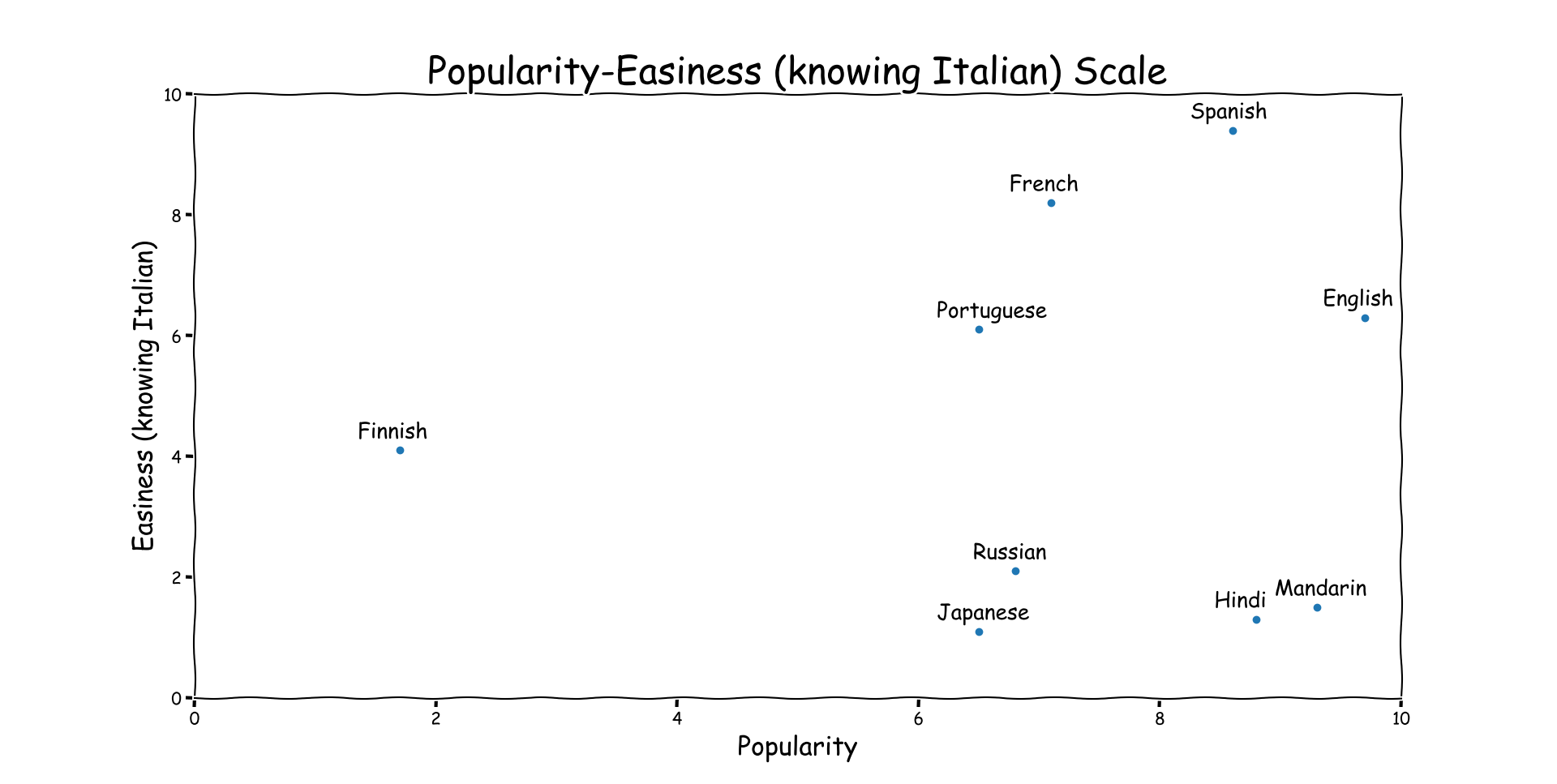When considering learning a new language, programming or human, the main driver is usually how “useful” that language is. A good proxy to measure it is how many people speak that language. Wikipedia informs us that the top 10 languages ordered by total speakers (eg. first + second language speakers) are:
| Language | Branch | Total speakers [millions] |
|---|---|---|
| English | Germanic | 1452 |
| Mandarin Chinese | Sinitic | 1118 |
| Hindi | Indo-Aryan | 602 |
| Spanish | Romance | 548 |
| French | Romance | 274 |
| Modern Standard Arabic | Semitic | 274 |
| Bengali | Indo-Aryan | 273 |
| Russian | Balto-Slavic | 258 |
| Portuguese | Romance | 258 |
| Urdu (excl. Hindi) | Indo-Aryan | 231 |
Italian ranks around the 30th place, with 68 millions speakers.
The second driver is probably easiness of learning and this is related to similarity of the languages you already know. For instance it’s much easier for someone speaking Italian learning Spanish (both Romanic languages) rather than for a German speaker.
A good way to represent this idea is to plot it. Note that the values assigned for popularity are mostly proportial to the number of speakers, while the easiness values are based on a vote of a sample of size 1 (truly yours).

Besides Italian and English, in the past I studied a little of French and Spanish that rank very high on both axis.
From the scatter plot you can easily get that in choosing the next language I should aim for something in the top right for istance getting better at French and Spanish.
After careful analysis I decided to learn Finnish!
Learning Finnish
Well that was because my veli (brother) Mikko announced in March 2022 that he was coming to Italy in May for a destination wedding of one of his Finnish friends and so he decided to learn a little of Italian with Duolingo.
You have to know that Mikko speaks Finnish, Swedish, English and French.
I met Mikko in 2010 when we were both exchange students in the US.
Besides the destination wedding in July he was getting married in Finland and we were invited.
So I thought it would make complete sense to learn a little Finnish. I had roughly 100 days before the wedding so I thought it would be cool to learn same basic vocabulary and useful sentences to be able to talk during the day. I already knew Missa vessa on? (Where is the restroom?) and all kinds of swear words, but for Mikko and Sonja’s big day I was planning to behave and not spending hours exploring the bathrooms of the wedding venue.
Therefore, I joined Duolingo and the mix of having a goal and the dopamine rush of XP (together with some threatening messages by Duo and Lily) propelled my way to higher and higher leagues.
Keeping a streak of days with a lesson done helped in building a daily habit. Anyway, when I landed with Elena in Helsinki I was extremely glad that English is a de facto standard not only in major cities but also in towns.
Nevertheless it was nice to utter some words in Finnish and make very little conversations. You could see the smile of appreciation of Finns (no easy feat) for having foreigners try to speak their language.
It’s useless to say that the only word that I grasped during the wedding celebration was rakkaus (love).
At the wedding venue, Elena and I were sitting together with Chris and Heidi (Mikko’s host parents) and other international guests. While chatting I figured out that one of the guys sitting with us directly from Switzerland was studying Finnish on Duolingo too. Do you know how you can test for this? Just ask what is vihrea velho (green wizard)!
I kept up with the lessons after the wedding and some week ago I reached the milestone of one year of learning (actually 400 days since I took me a while to write this). So it’s a good time to analyze what I learned and how useful was Duolingo.
Duolingo review
PROs
- Keeping intact the streak makes me work on my Finnish even when I don’t feel like take a lesson.
- Talking about my idea of learning Finnish during a family dinner convinced my mom to start learning English and she is getting better and better at it.
- The recently introduced Friends quest and the mechanism of complimenting is a good way to keep in touch with the Finn.
- Studying Finnish paired with English helps me in refreshing some of the syntax that I mess up in English.
- It’s a nice way to start a conversation in conferences/network events, especially if there is a Finn.
CONs
- The goal of getting XP to advance you to the next league push you to leverage some tricks like playing hard while you have XP boost and be lazier when you are not. Maybe it’s a case of Goodheart’s law?
- Not having to actively use or plan to use the language makes the learning less interesting.
- Some of the sentences to translate are completely off (like people marrying with bears or green wizards).
- My level of Finnish after a year is very very low.
- When it’s 10 p.m. and I haven’t complete a lesson Duo starts to threaten me.
Summing it up using Duolingo to get the basics of a language can be nice, but it’s much more what it gives you in terms of community. I think that I would use it also to learn another language (maybe German?), but for sure i do not expect to be sufficient to reach any level of fluency.